Abstract
Reproductive and endocrine function was investigated in 22 women with Hodgkin's disease who had bilateral mid-line oophoropexies performed at staging laparotomy. The operation was followed in 12 cases by "inverted Y" pelvic lymph node irradiation and in 4 cases by para-aortic lymph node irradiation. Pregnancies occurred after the operation in 4 of the 6 patients subsequently found not to require irradiation below the diaphragm. In the other 2 patients in this group the menstrual history was unaffected and normal gonadotrophin concentrations indicated intact ovarian function. In the group receiving para-aortic irradiation, in whom the ovarian irradiation dose was was small (about 150 rad to each ovary) menstrual function and gonadotrophin concentrations were normal at the time of review and one patient has subsequently become pregnant. In the group receiving inverted Y irradiation, in whom the ovaries were shielded from the radiation beam by a rectangular lead block, the ovarian dose was much higher (lowest dose 600 rad, highest dose 3500 rad). Nine of the 12 have persisting amenorrhoea with elevated levels of both gonadotrophins. One patient has since become pregnant and one patient has resumed menstrual cycles and has normal basal gonadotrophin concentrations. One patient who has resumed menstrual cycles has a monotrophic elevation of basal serum FSH concentrations. We conclude that bilateral mid-line oophoropexy does not impair ovarian function or gamete transport and should be performed at diagnositc laparotomy in women of child bearing age with Hodgkin's disease, even when it is uncertain whether pelvic node irradiation will be necessary. The results in the patients who received inverted Y irradiation indicate that the technique of pelvic shielding and ovarian transposition used were only partially successful in preserving fertility. Alternative techniques for preserving ovarian function are discussed.
Full text
PDF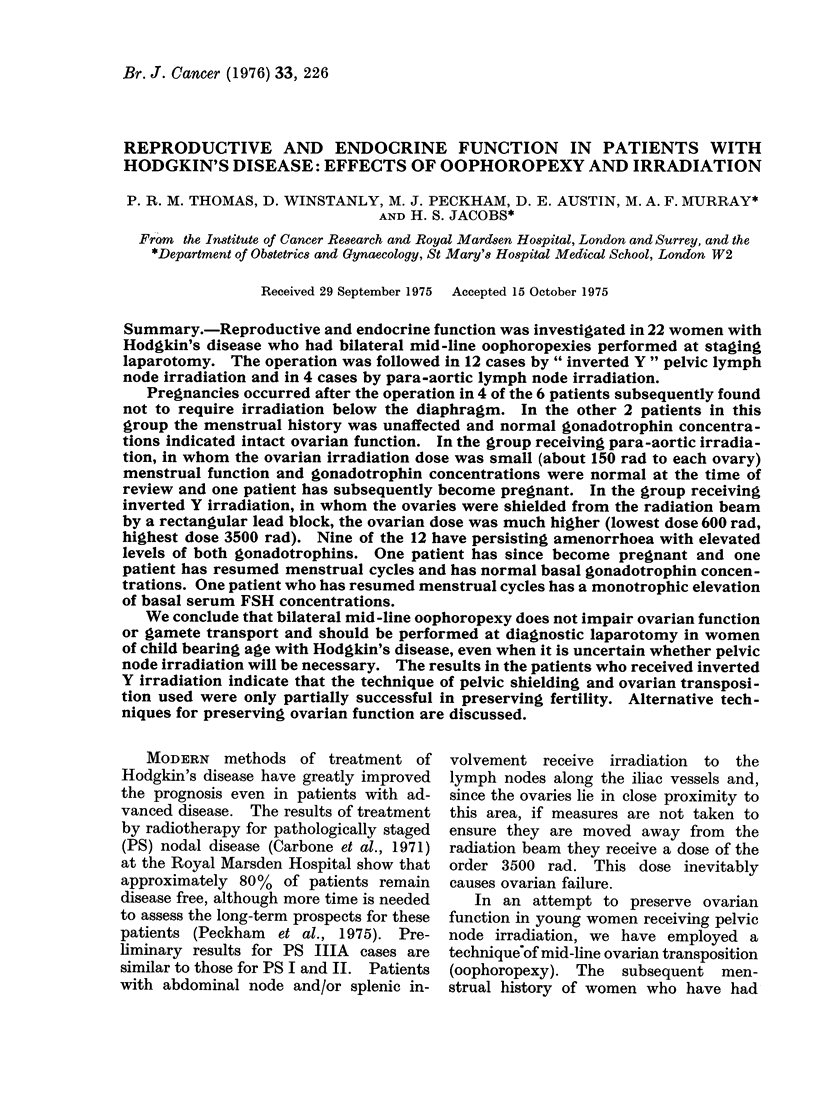
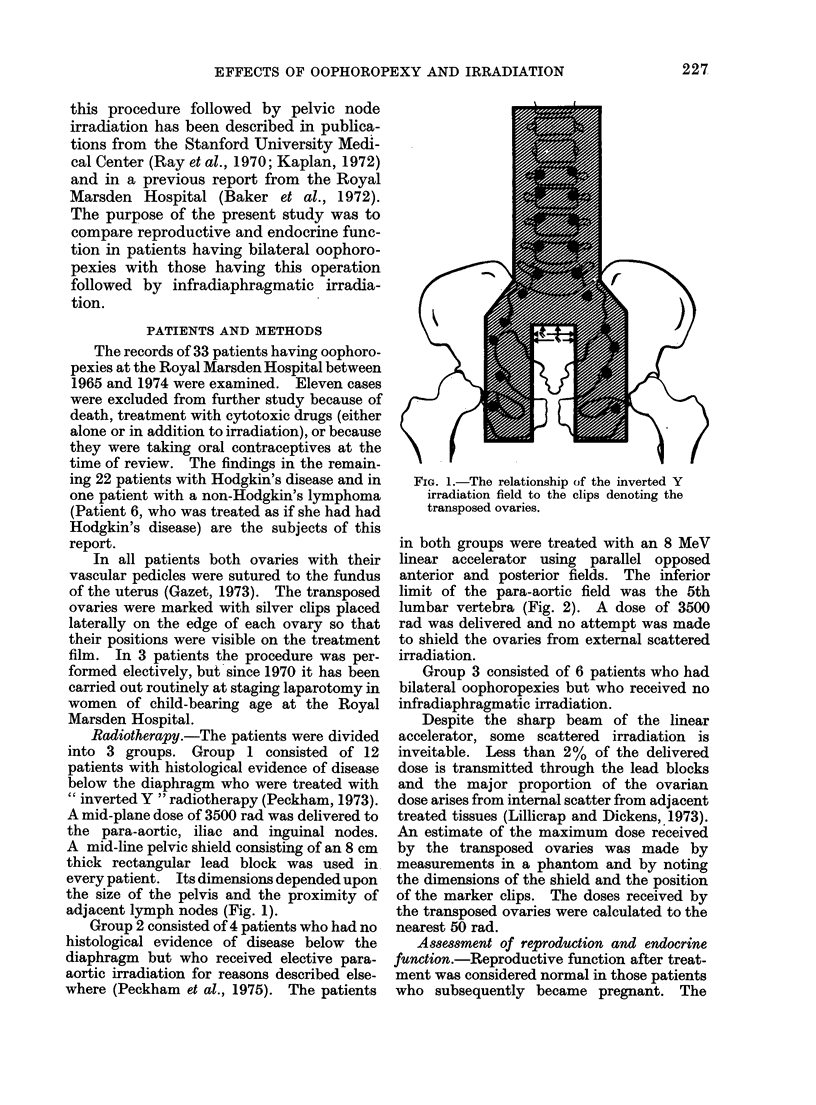
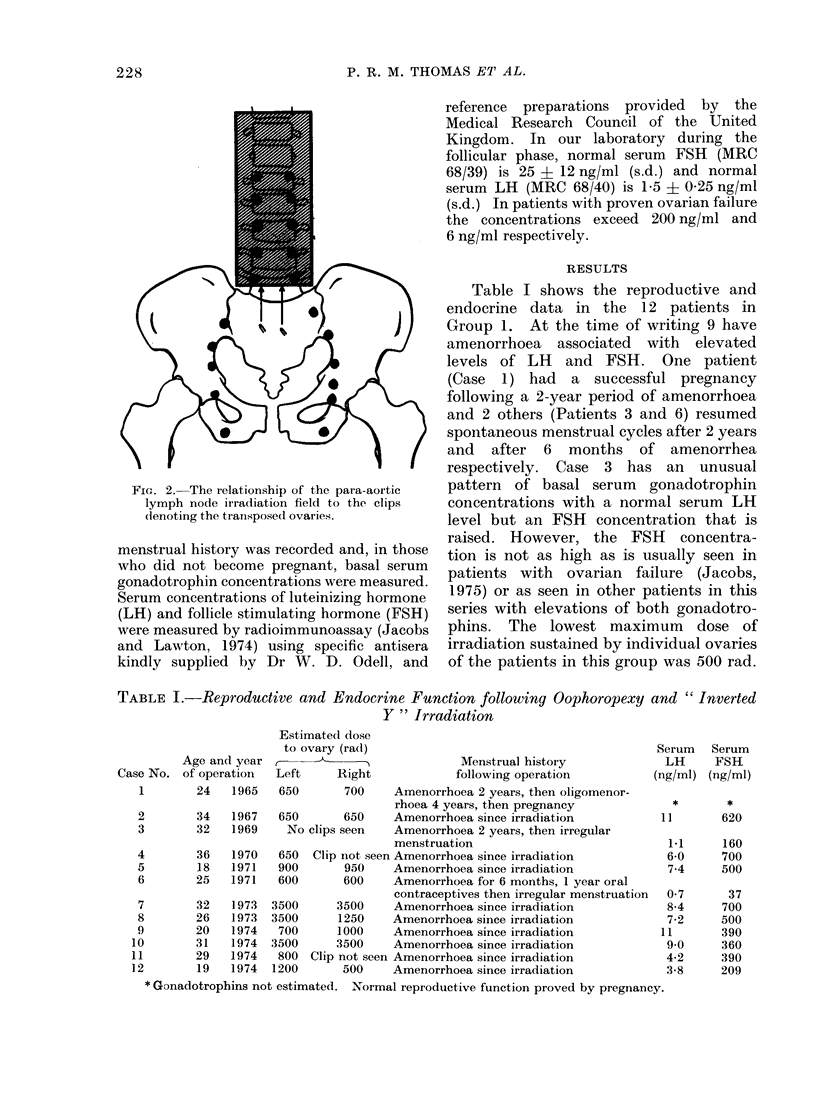
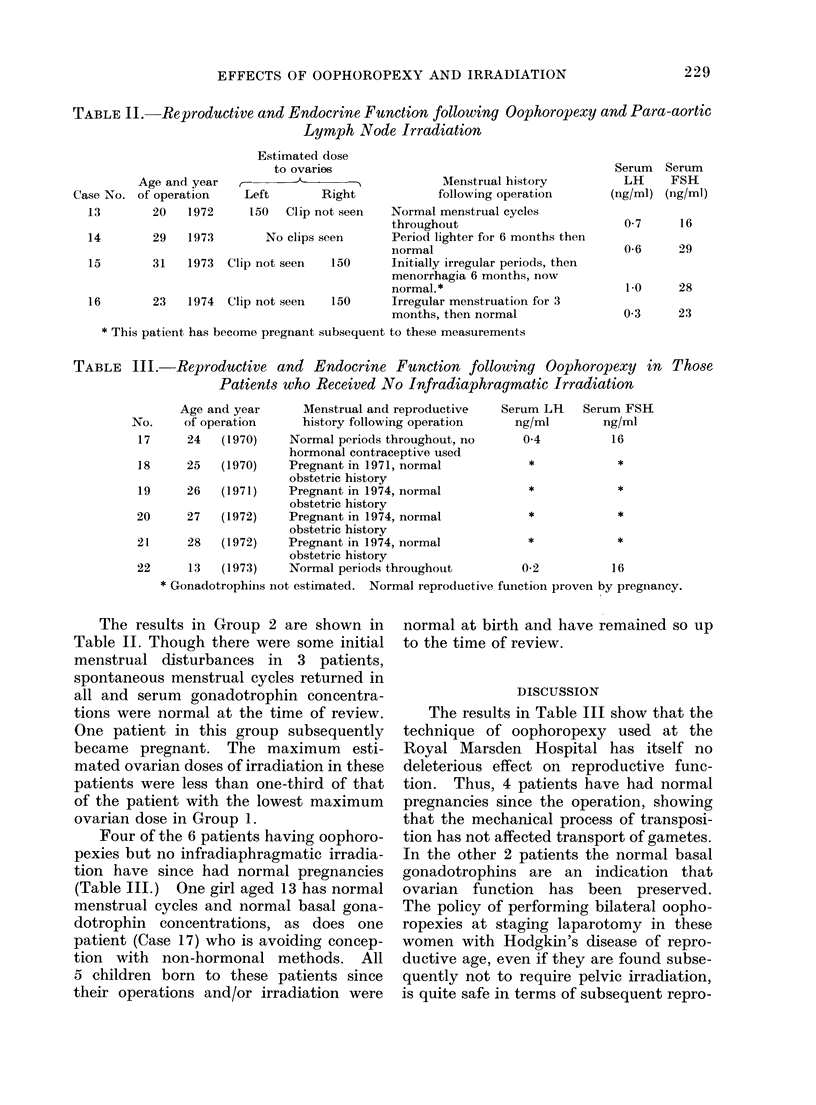
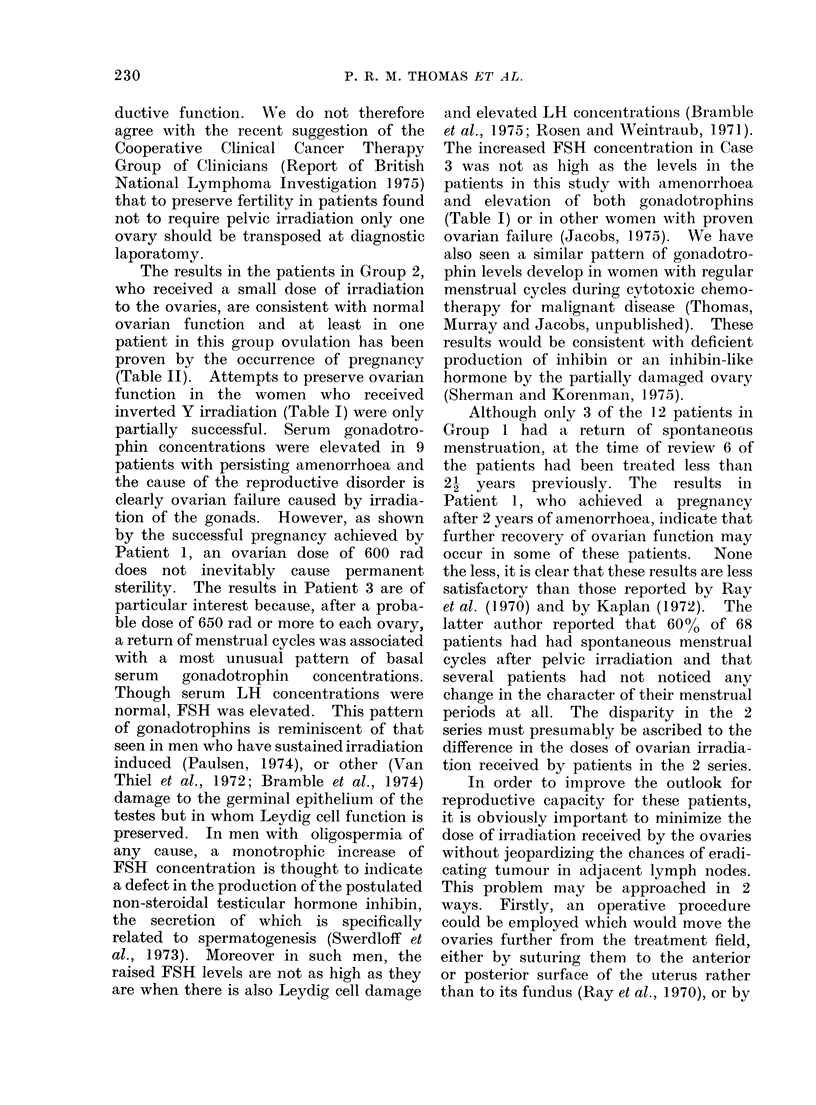
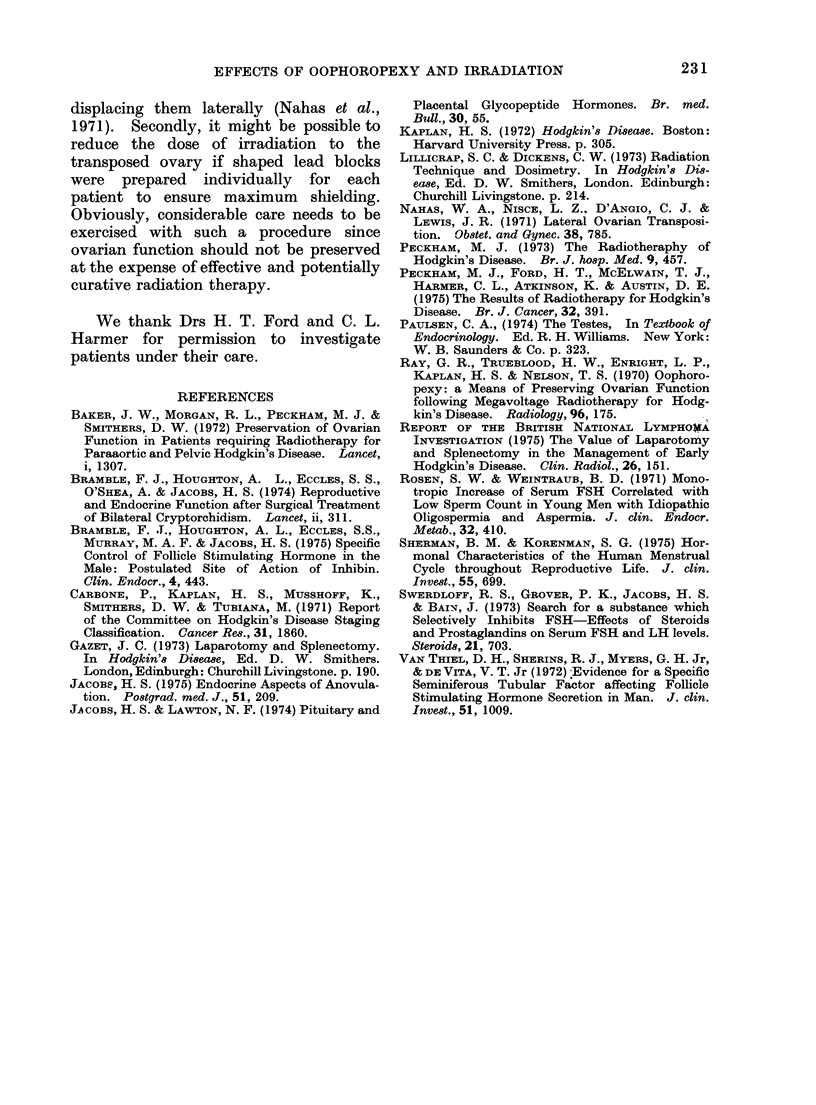
Selected References
These references are in PubMed. This may not be the complete list of references from this article.
- Baker J. W., Morgan R. L., Peckham M. J., Smithers D. W. Preservation of ovarian function in patients requiring radiotherapy for para-aortic and pelvic Hodgkin's disease. Lancet. 1972 Jun 17;1(7764):1307–1308. doi: 10.1016/s0140-6736(72)91035-5. [DOI] [PubMed] [Google Scholar]
- Bramble F. J., Houghton A. L., Eccles S. S., Murray M. A., Jacobs H. S. Specific control of follicle stimulating hormone in the male: postulated site of action of inhibin. Clin Endocrinol (Oxf) 1975 Jul;4(4):443–449. doi: 10.1111/j.1365-2265.1975.tb01552.x. [DOI] [PubMed] [Google Scholar]
- Bramble F. J., Houghton A. L., Eccles S., O'Shea A., Jacobs H. S. Reproductive and endocrine function after surgical treatment of bilateral crytorchidism. Lancet. 1974 Aug 10;2(7876):311–314. doi: 10.1016/s0140-6736(74)91692-4. [DOI] [PubMed] [Google Scholar]
- Carbone P. P., Kaplan H. S., Musshoff K., Smithers D. W., Tubiana M. Report of the Committee on Hodgkin's Disease Staging Classification. Cancer Res. 1971 Nov;31(11):1860–1861. [PubMed] [Google Scholar]
- Jacobs H. S. Endocrine aspects of anovulation. Postgrad Med J. 1975 Apr;51(594):209–214. doi: 10.1136/pgmj.51.594.209. [DOI] [PMC free article] [PubMed] [Google Scholar]
- Jacobs H. S., Lawton N. F. Radioimmunoassay and saturation analysis. Pituitary and placental glycopeptide hormones. Br Med Bull. 1974 Jan;30(1):55–61. doi: 10.1093/oxfordjournals.bmb.a071168. [DOI] [PubMed] [Google Scholar]
- Peckham M. J., Ford H. T., McElwain T. J., Harmer C. L., Atkinson K., Austin D. E. The results of radiotherapy for Hodgkins' disease. Br J Cancer. 1975 Sep;32(3):391–400. doi: 10.1038/bjc.1975.239. [DOI] [PMC free article] [PubMed] [Google Scholar]
- Ray G. R., Trueblood H. W., Enright L. P., Kaplan H. S., Nelsen T. S. Oophoropexy: a means of preserving ovarian function following pelvic megavoltage radiotherapy for Hodgkin's disease. Radiology. 1970 Jul;96(1):175–180. doi: 10.1148/96.1.175. [DOI] [PubMed] [Google Scholar]
- Rosen S. W., Weintraub B. D. Monotropic increase of serum FSH correlated with low sperm count in young men with idiopathic oligospermia and aspermia. J Clin Endocrinol Metab. 1971 Mar;32(3):410–416. doi: 10.1210/jcem-32-3-410. [DOI] [PubMed] [Google Scholar]
- Sherman B. M., Korenman S. G. Hormonal characteristics of the human menstrual cycle throughout reproductive life. J Clin Invest. 1975 Apr;55(4):699–706. doi: 10.1172/JCI107979. [DOI] [PMC free article] [PubMed] [Google Scholar]
- Swerdloff R. S., Grover P. K., Jacobs H. S., Bain J. Search for a substance which selectively inhibits FSH--effects of steroids and prostaglandins on serum FSH and LH levels. Steroids. 1973 May;21(5):703–722. doi: 10.1016/0039-128x(73)90137-2. [DOI] [PubMed] [Google Scholar]
- The value of laparotomy and splenectomy in the management of early Hodgkin's disease. A report from the British National Lymphoma Investigation. Clin Radiol. 1975 Apr;26(2):151–157. doi: 10.1016/s0009-9260(75)80034-1. [DOI] [PubMed] [Google Scholar]
- Van Thiel D. H., Sherins R. J., Myers G. H., Jr, De Vita V. T., Jr Evidence for a specific seminiferous tubular factor affecting follicle-stimulating hormone secretion in man. J Clin Invest. 1972 Apr;51(4):1009–1019. doi: 10.1172/JCI106861. [DOI] [PMC free article] [PubMed] [Google Scholar]


